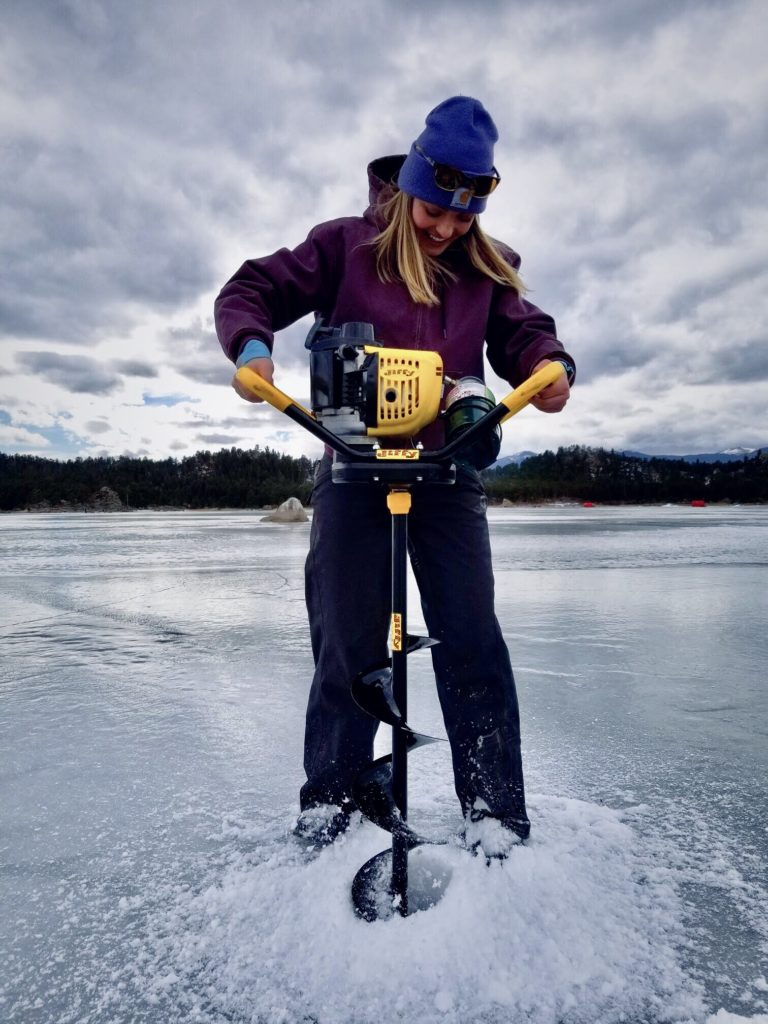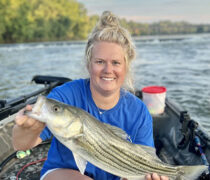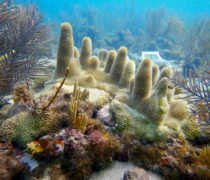Ice fishing 101: Get your ‘fish on!’

By Lauren Klamm, Artemis Ambassador – Fort Collins, CO
Despite what many people think, ice fishing or ‘hard-water fishing’ is a lot of fun and an effective way to catch fish. Just like any outdoor activity, ice fishing requires planning and preparation not only for success and comfort but also for safety. Here are some tips to start a safe and successful ice fishing adventure:
What to bring –
- Ice rods and reels: You may feel silly the first time you pick up an ice fishing pole, but the 24 to 36-inch rods are designed explicitly for hard-water fishing and will make sense when you hover over a six to an eight-inch hole. Ice rods come in many different styles, lengths, and actions to match other lures and the different species you will target. Ultralight reels designed for ice fishing also tend to be significantly less expensive than corresponding open water reels.
- Ice auger and scoops: An ice auger is a spiral cutting tool to make holes in the ice. Augers come in a variety of sizes to create different size holes. Gasoline or battery-powered augers are less labor-intensive to use than a handheld auger and allow an angler to cut more holes and fish a larger area of water. Whichever auger you choose, make sure you also have a strainer style ice-scoop to clear ice chunks and snow out of the holes you drill.
- Seat: Five-gallon buckets are fantastic pieces of equipment for ice fishing. You can use them to carry gear, keep your fish, and they also make excellent seats as you patiently work a productive hole. Your local tackle dealer will likely have bucket caps designed for seating. Ice fishing is also a great time to crack out your camping chairs!

- Pliers or forceps: Bring needle-nose pliers or small forceps to remove hooks from fish and to secure split shots to your line.
- Sled: A flat-bottomed plastic sled is an excellent way to carry your equipment. Choose a sled large enough to carry your essentials with a little extra space.
- Electronics: Portable depth finders can make your ice fishing far more productive and fun. Depth finders range from sophisticated units with GPS tracking to handheld units with liquid crystal displays. I am a big fan of MarCum Technologies and love to watch the fish chase my bait up the water column.
- Line: Fish under the ice are slower and will put up less of a fight than in warm water conditions. A six or eight-pound test may qualify as “light” in open water, but ice anglers commonly scale down to a four, three, or two-pound test.
- Tackle: Split shot weights help your baited hooks, and light jigs get down more quickly. They can make it easier to detect a light bite. As for hooks, bring a mix of light wire hooks in a variety of sizes. Small hooks in a #8 to #14 range will work well with small delicate baits like wax worms. For minnows, start with hooks size #4 and #2. Adjust to larger or smaller hooks to match the size of minnows you are using.
- Lures: In most cases, you should choose small lures. Ice fishing spoons or small jigs are made to sink quickly and exhibit an enticing action when using a vertical jigging motion. My favorite lure is a gold Acme Kastmaster spoon with vertical jigging, but don’t be afraid to switch up your lures. Sometimes a change is all it takes to intrigue a fish, so experiment to see what will work best for you.
- Live bait: Check with a knowledgeable bait shop on what baits are available, practical, and legal in your local waters. Minnows will catch trout and other larger species. When fishing for panfish, try wax worms or bug-like plastics.
- Tip-ups: If you would like to catch bigger fish while you actively fish other holes, you should consider purchasing a few tip-ups. Tip-ups are designed to straddle an ice fishing hole to present stationary bait. They are also equipped with a signaling device to indicate a strike. Be ready to run when a flag goes up.

- Other Essentials: Don’t forget your fishing license! Bring insulated boots, warm gloves, a hat, and many layers because being on the ice all day can get very chilly! Snacks and beverages are also a must.
- Pro-Tip: If your feet get cold easily, or if you don’t have great boot, bring a small matt or something to keep your feet off the ice.
Where to ice fish –
Start by fishing bays, harbors, backwaters, and channels off of larger rivers and lakes. These areas are generally shallow and are the first to freeze, which will make them popular spots for a variety of species in the winter. You may find a group of anglers gathered near successful fishing holes. Don’t get too close, but it is good to follow the paths others have recently taken to avoid thin ice.

How to fish –
Coldwater fishing calls for light line, small baits, and slow assertive vertical presentation to the fish. To find what the fish prefer, vary your rod movement and your bait’s position in the water column.
You can try lifting and dropping your lure or a series of jigging motions. You can also use a subtle quivering motion or a motionless “dead stick” presentation. Most fish seem to spend time within the bottom two feet of the water column. Be sure you have several lures and bait options while fishing and change them until you find the most enticing combination.
Join the ice fishing community this winter – it’s a great way to enjoy the crisp air, fresh fillets, and fun fishing.






